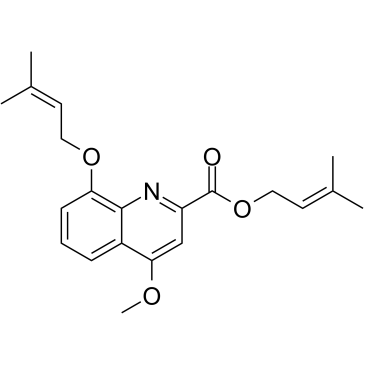1245818-17-0
| Name | Ppc-1 |
|---|
| Description | Ppc-1 is a mitochondrial uncoupler. Ppc-1 enhances mitochondrial oxygen consumption without adverse effects on ATP production. Ppc-1 is a cell-permeate interleukin-2 (IL-2) inhibitor. Ppc-1 inhibits the Gram-negative periodontopathogen Porphyromonas gingivalis. Ppc-1 has anti-obesity, antibacterial and anti-inflammatory activities[1][2][3][4]. |
|---|---|
| Related Catalog | |
| Target |
Mitochondrial[1] Interleukin-2 (IL-2)[2] Porphyromonas gingivalis[4] |
| In Vitro | Ppc-1 treatment (0-10 μM; 24 hours; Jurkat cells) significant inhibits IL-2 production in Jurkat cells with an IC50 of 4 μM[2]. Ppc-1 (compound 6) has antiproliferative activities in K562 human leukemia, Hela cervical carcinoma, and 3T3-L1 mouse embryonic fibroblast cells. Ppc-1 shows about 50% inhibition at 15 μM in all cell lines. Ppc-1 inhibits the growth of K562 cells with an EC50 of 13 μM[3].Using the U937-3xκB-LUC human monocytic cell line, Ppc-1 dose-dependently inhibits the lipopolysaccharide-induced NF-κB activation[4]. |
| In Vivo | Ppc-1 (0-10 mg /kg; Intraperitoneal injection; once a week; for 8 weeks; female ICR mice) treatment suppresses weight gain with no abnormal effects on liver or kidney tissues, and no evidence of tumor formation[1]. Serum fatty acid levels are significantly elevated in mice treated with Ppc-1, while body fat content remained low. After a single administration, Ppc-1 distributes into various tissues of individual animals at low levels. Ppc-1 stimulates adipocytes in culture to release fatty acids, which might explain the elevated serum fatty acids in Ppc-1-treated mice[1]. Animal Model: Female ICR mice[1] Dosage: 0 mg /kg , 0.16 mg /kg, 0.8 mg /kg, 4 mg /kg, and 10 mg /kg Administration: Intraperitoneal injection; once a week; for 8 weeks Result: Suppresseed weight gain in animals. |
| References |
| Molecular Formula | C21H25NO4 |
|---|---|
| Molecular Weight | 355.43 |
